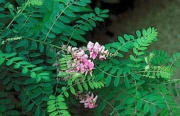Revision as of 11:39, 27 April 2013 by (username removed)
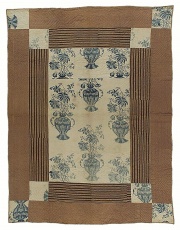
Pieced quilt American United States, New York, late 18th century Printed cotton plain weave; pieced and quilted 238 x 183.5 cm (93 11/16 x 72 1/4 in.) Museum of Fine Arts, Boston: Gift of Mrs. Edward E. Harkavy 49.414
for more information see: MFA Online Collections Database Description
Synonyms and Related Terms
2,2'-biindolinyliden-3,3'-dion; Indigofera tinctoria; Natural Blue 1; CI 75780 (natural); Vat Blue 1; CI 73000 (synthetic); Pigment Blue 66; indigotin; indicum (Pliny); indigo (Esp. Fr., Dan., Ned., Port., Sven.); Indigo (Deut.); anil (Esp.); Indiko (Gr.); indaco (It.); aneel; anile; ai (Jap.); rams (Tibetan); blue ynde; blue inde; anneil; India blue; intense blue; rock indigo; stone blue; indigo carmine; intense blue; indico; indicoe; indego; nil
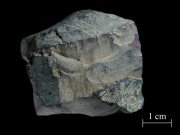
Photomacrograph of a piece of indigo. Photo credit: Keith Lawrence, Museum of Fine Arts, Boston
Other Properties
Soluble in nitrobenzene, phenol, chloroform, glacial acetic acid. Insoluble in water, ethanol, acetone, ethyl acetate, pinene.
Absorption max = 599 (in xylene).
ISO R105 Lightfastness Classification = 3-4
Microscopically, indigo has fine, translucent dark blue, rounded particles that are weakly birefringent and appear red under Chelsea filter.
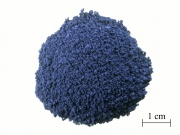
Photomacrograph of indigo powder from the Botanical Museum, Harvard University. Photo credit: Keith Lawrence, Museum of Fine Arts, Boston
| Composition
|
C16H10N2O2
|
| CAS
|
482-89-3
|
| Melting Point
|
390-392
|
| Molecular Weight
|
mol. wt. = 262.26
|
| Refractive Index
|
>1.662
|
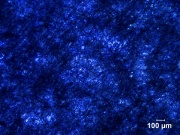
Brightfield transmitted light photomicrograph of paper dyed with indigo at 50X. Sample provided by the Asian Conservation Laboratory, MFA. Photo credit: Keith Lawrence, Museum of Fine Arts, Boston
Hazards and Safety
Discolored by reducing agents and bleaches.
Fisher Scientific: MSDS
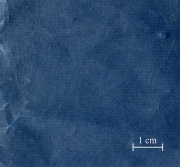
Photomacrograph showing paper dyed with indigo. Sample provided by the Asian Conservation Laboratory, MFA. Photo credit: Keith Lawrence, Museum of Fine Arts, Boston
Additional Information
H.Schweppe, "Indigo and Woad", Artists Pigments, Volume 3, E. West FitzHugh (ed.), Oxford University Press: Oxford, 1997. Pigments Through the Ages: Indigo
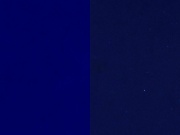
Normal (left) and UV (right) reflected light images at 100x of pigment/collodion mixture on glass slide to illustrate pigment color along with presence or absence of autofluorescence. Normal light = Halogen lamp (100 W, no filter); UV light=Mercury gas discharge lamp (100W, excitation filter=340-380nm, suppression filter=425 nm). Image credit=Scientific Research lab, Museum of Fine Arts, Boston.
Comparisons
Characteristics of Common Blue Pigments


